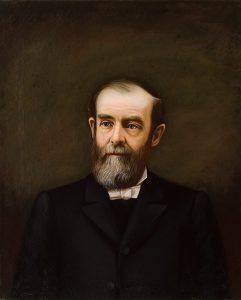View artwork
Frank Stadter was known as a portrait artist but that was only one side of a very interesting man. He was born Boleslaus Horodynski in about 1843 in Poland. He fled Poland in 1863 during political uprisings and, like many immigrants to America, he changed his name, apparently using a name that was similar to that of his good friend, Frank Stadelman. Stadter settled in the Plattsmouth, Nebraska area and lived there from 1868 to 1877.
He painted portraits, murals, and landscapes while living in Plattsmouth, and most of his paintings are signed Frank Stadter. He was very involved in the local Plattsmouth community. He worked with his friend Stadelman in Stadelman’s bakery before opening his own business selling a wide array of useful items plus paints and brushes and all sorts of paintings. He also served as a volunteer in the fire department and was appointed Assistant Foreman. One year he and another friend, Adolph d’Allemand, were in charge of the July 4th fireworks. Stadter was also an inventor with patents for a fuel-saving drum for wood and coal stoves in 1869 and a double-convex globe to increase the strength of artificial light in 1871.
In the late 1870s, Stadter was appointed to help establish the Art Department at the University of Nebraska in Lincoln where he taught drawing and painting.
He returned to Poland in the 1880s as the U. S. Consul in Warsaw. In 1902 a caricature of Stadter as Uncle Sam appeared in a Polish newspaper. In 1926 he wrote to the Lincoln State Journal newspaper requesting a photograph of his Self Portrait which had been given to the Palladian Literary Society at the University. However, the painting could not be located.
The family home was destroyed by German bombs during World War II and all of Stadter’s paintings and correspondence were destroyed according to his granddaughter.
The one work in the Museum of Nebraska Art Collection (MONA) by Stadter is a portrait titled Reverend James Dinsmore Kerr. Reverend Kerr was a traveling Presbyterian minister in eastern Nebraska in the 1870s. Kerr’s portrait hung in the Presbyterian Church in Bellevue until Mrs. Harold (Luella) LaMar (mother of Lorraine Rohman) purchased the church to save it from being torn down. She apparently took the portrait home to keep it safe and in 1984 Lorraine Rohman donated the painting to MONA. The portrait had moderate damage from a pair of candles that had been placed too close to it, but has now been restored.
Researched and written by Jean Jacobson, 2013, a project of MONA’s Bison Society.
Sources:
Cass County Historical Society, Nebraska.
Lincoln State Journal, April 25, 1926.
Nebraska Art Association Semi-Centennial Annual Exhibition of Painting 1940.










